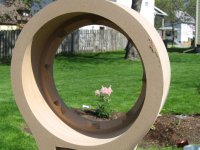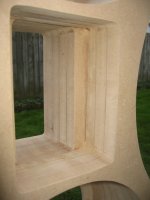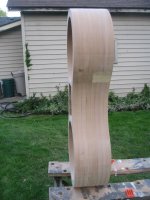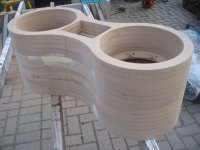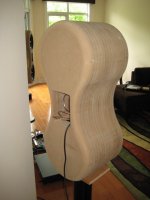Small Update
Hi Guys,
Sorry for the long absence, as I said before, progress has been slow, but certainly not at a standstill.
The good news is that I'll be finishing the cabinets over next weekend, then it's on to the crossover which will make for much more interesting reading, and more frequent updates.
The cabinets are still progressing, and I'll attach a few pictures of where they're at right now. Needless to say, I'm looking forward to having them finished so I can get on with my measurements.
Some pictures to follow, along with some subwoofer talk.
Cheers,
Owen
Hi Guys,
Sorry for the long absence, as I said before, progress has been slow, but certainly not at a standstill.
The good news is that I'll be finishing the cabinets over next weekend, then it's on to the crossover which will make for much more interesting reading, and more frequent updates.
The cabinets are still progressing, and I'll attach a few pictures of where they're at right now. Needless to say, I'm looking forward to having them finished so I can get on with my measurements.
Some pictures to follow, along with some subwoofer talk.
Cheers,
Owen
Attachments
Here's the tweeter cutout. The crossovers will be housed in this opening, and then a back plate with the binding posts on it will be flush mounted to seal it off. The back of the tweeter will be accessible from in there, and I'll have to drill two holes to run wires to the TD10M's.
I was debating trying to take one of the ribbons apart to see if there was a possibility of removing the rear chamber/transformer and using the larger chamber instead, but I haven't worked up the courage to try it yet.
I'm wondering if maybe be the bump from 9-15kHz is related to the built in rear chamber? It's more likely that it's the magnets and faceplate, but it might be worth a shot.
I was debating trying to take one of the ribbons apart to see if there was a possibility of removing the rear chamber/transformer and using the larger chamber instead, but I haven't worked up the courage to try it yet.
I'm wondering if maybe be the bump from 9-15kHz is related to the built in rear chamber? It's more likely that it's the magnets and faceplate, but it might be worth a shot.
Attachments
Here's a side view, and it's currently 8 layers deep. The ninth layer has since been put on, and there are 13 left to go. Tapering will start with the 10th layer.
Notice the wood filler which was used to even out a small ding where the router angled in a little while flush trimming. Any mistake has to be fixed right away, or it'll carry through to subsequent layers. Diligent sanding and careful trimming are a must for every layer.
Notice the wood filler which was used to even out a small ding where the router angled in a little while flush trimming. Any mistake has to be fixed right away, or it'll carry through to subsequent layers. Diligent sanding and careful trimming are a must for every layer.
Attachments
Now on to the subwoofer, which has been a major source of flip-flopping and debate for me.
I want something a reasonable size, so 11 foot long TL's are out of the question. I'm not going to get bent out of shape over the low frequency extension, so I think 30Hz is a pretty good target. This isn't for movies, and I'm not a very big fan of organ music, so going down to 15Hz isn't a priority for me.
It doesn't have to play excessively loud, but it does need to have impact and immediacy, and it will have to blend well with the TD10M / Neopro5i's.
Power is not an issue, as I have access to some pretty serious amplification if it's needed. DSP and EQ is also not an issue, and I have no problem using either in the bass region. Driver cost is a bit of a limitation, but if it's going to provide great bass, then I'm pretty flexible. I would say $700-$800 is my limit for a pair of drivers.
I want two subwoofers, one beside each speaker, as previous experience has shown that I have a definite preference for stereo subwoofer setups.
Here are the types I've considered, along with comments:
1- Sealed / critically damped with EQ.
2- OB or U style enclosure with some EQ
3- "El-Pipo" style TL (These are too long / big)
4- Tapped horns (I'm worried about group delay and size)
5- Ported (I have several concerns about ported enclosures)
6- Passive Rad. (I've never heard one that I like)
I know I like the sound and impact of larger drivers, so I'm pretty sold on larger 15" - 21" pro sound stuff. So far, given my requirements for size, output and extension, the sealed enclosure is looking pretty good. If I don't need excessive output, and I only want to go down to 30Hz or so, then I don't need ridiculous amounts of EQ and power to get there. Larger format drivers are already very efficient, so with the right driver in the right enclosure, I might be able to get to where I'd like to be.
Does anyone have any experience with the absurd Pyle Pro PDW21250? I've read Magnetar's thread about the Stargate OB's, and I've also read over this excellent write up:
http://www.humblehomemadehifi.com/Serious-Sub.html
The 21" Pyle driver aligns into a 3 cubic foot enclosure, and ends up with an F3 of about 65Hz. That means I'd only need about 12dB of EQ to get into the low 30's, and since that driver is already between 95 and 100dB at 1W, then I could easily play up to 100-110dB with a reasonable amount of power.
I'm definitely hesitant to trust such an important job to such a mediocre quality driver, but in this case, the simple size of the thing might make up for any shortcomings.
John:
How do you think a pair of your 18" drivers would do in a sealed box? Have you built anything subwoofer-wise with the TD18H+? Anything in a serious installation would likely be ported, but have you tried any other alignments?
I like the looks of the 15" PR you posted, but I'm not sure it's my cup of tea. Are those phase plugs you used for the feet? I like them!
Any comments are welcome... I need to stop thinking about it and just commit to something. Maybe I'll buy a pair of those Pyle drivers just to toy around with. They're not prohibitively expensive, and they're unique enough that I could probably sell them if if they didn't work out.
Cheers,
Owen
I want something a reasonable size, so 11 foot long TL's are out of the question. I'm not going to get bent out of shape over the low frequency extension, so I think 30Hz is a pretty good target. This isn't for movies, and I'm not a very big fan of organ music, so going down to 15Hz isn't a priority for me.
It doesn't have to play excessively loud, but it does need to have impact and immediacy, and it will have to blend well with the TD10M / Neopro5i's.
Power is not an issue, as I have access to some pretty serious amplification if it's needed. DSP and EQ is also not an issue, and I have no problem using either in the bass region. Driver cost is a bit of a limitation, but if it's going to provide great bass, then I'm pretty flexible. I would say $700-$800 is my limit for a pair of drivers.
I want two subwoofers, one beside each speaker, as previous experience has shown that I have a definite preference for stereo subwoofer setups.
Here are the types I've considered, along with comments:
1- Sealed / critically damped with EQ.
2- OB or U style enclosure with some EQ
3- "El-Pipo" style TL (These are too long / big)
4- Tapped horns (I'm worried about group delay and size)
5- Ported (I have several concerns about ported enclosures)
6- Passive Rad. (I've never heard one that I like)
I know I like the sound and impact of larger drivers, so I'm pretty sold on larger 15" - 21" pro sound stuff. So far, given my requirements for size, output and extension, the sealed enclosure is looking pretty good. If I don't need excessive output, and I only want to go down to 30Hz or so, then I don't need ridiculous amounts of EQ and power to get there. Larger format drivers are already very efficient, so with the right driver in the right enclosure, I might be able to get to where I'd like to be.
Does anyone have any experience with the absurd Pyle Pro PDW21250? I've read Magnetar's thread about the Stargate OB's, and I've also read over this excellent write up:
http://www.humblehomemadehifi.com/Serious-Sub.html
The 21" Pyle driver aligns into a 3 cubic foot enclosure, and ends up with an F3 of about 65Hz. That means I'd only need about 12dB of EQ to get into the low 30's, and since that driver is already between 95 and 100dB at 1W, then I could easily play up to 100-110dB with a reasonable amount of power.
I'm definitely hesitant to trust such an important job to such a mediocre quality driver, but in this case, the simple size of the thing might make up for any shortcomings.
John:
How do you think a pair of your 18" drivers would do in a sealed box? Have you built anything subwoofer-wise with the TD18H+? Anything in a serious installation would likely be ported, but have you tried any other alignments?
I like the looks of the 15" PR you posted, but I'm not sure it's my cup of tea. Are those phase plugs you used for the feet? I like them!
Any comments are welcome... I need to stop thinking about it and just commit to something. Maybe I'll buy a pair of those Pyle drivers just to toy around with. They're not prohibitively expensive, and they're unique enough that I could probably sell them if if they didn't work out.
Cheers,
Owen
Hi Guys,
The cabinets are finally finished! Well, not really finished, but ready for measurements!
It took a whirlwind weekend of gluing and routing, but the basic shells are finished. All that remains is the sealing, lots of sanding, and then off to an auto body shop for a coat of pearl white.
I know a fellow who does a lot of artistic welding as a hobby, so I'm going to talk to him about possible stands for these. Right now I'm thinking about a large metal base, with a small I-beam that runs up the back, and bolts to the rear of the speaker. This would let me eventually bolt a pair of subwoofers the the same stand without needing to put them to the side. It would also give me some height adjustment if I make a clever mounting bracket.
This weekend is measurement weekend, so I'll be updating with some proper in-box measurements, which is what I'll be using to design the crossover. I'm also going to re-do the active EQ thing to try a few different slopes and crossover points to see what I prefer.
If all goes well, I will hopefully be making a trip to Toronto in the next few weeks to take some full scale measurements in a real anechoic chamber. I'm very interested to see how these will compare with what I measure here.
I've attached a few pictures, and I'll follow up with some impedance and FR measurements in the actual box. I'm also going to establish proper SPL levels for the TD10M's and the NeoPro5i, so that should be interesting as well.
On that note, can anyone comment on the best way to do the reference SPL measurements? I have an accurate SPL meter (Extech Instruments 407730) and a microphone stand. My plan was to mount the meter in the stand and place it 1m from the speakers. I was then going to use a 2.83V sine signal at 1000Hz for the woofers and 4000Hz for the tweeters, and just get the SPL reading. Would this be a logical way to do it? I'm sure the room is going to contribute somewhat, but at least I would have a decent starting point. If there is a better way, let me know.
Cheers,
Owen
The cabinets are finally finished! Well, not really finished, but ready for measurements!
It took a whirlwind weekend of gluing and routing, but the basic shells are finished. All that remains is the sealing, lots of sanding, and then off to an auto body shop for a coat of pearl white.
I know a fellow who does a lot of artistic welding as a hobby, so I'm going to talk to him about possible stands for these. Right now I'm thinking about a large metal base, with a small I-beam that runs up the back, and bolts to the rear of the speaker. This would let me eventually bolt a pair of subwoofers the the same stand without needing to put them to the side. It would also give me some height adjustment if I make a clever mounting bracket.
This weekend is measurement weekend, so I'll be updating with some proper in-box measurements, which is what I'll be using to design the crossover. I'm also going to re-do the active EQ thing to try a few different slopes and crossover points to see what I prefer.
If all goes well, I will hopefully be making a trip to Toronto in the next few weeks to take some full scale measurements in a real anechoic chamber. I'm very interested to see how these will compare with what I measure here.
I've attached a few pictures, and I'll follow up with some impedance and FR measurements in the actual box. I'm also going to establish proper SPL levels for the TD10M's and the NeoPro5i, so that should be interesting as well.
On that note, can anyone comment on the best way to do the reference SPL measurements? I have an accurate SPL meter (Extech Instruments 407730) and a microphone stand. My plan was to mount the meter in the stand and place it 1m from the speakers. I was then going to use a 2.83V sine signal at 1000Hz for the woofers and 4000Hz for the tweeters, and just get the SPL reading. Would this be a logical way to do it? I'm sure the room is going to contribute somewhat, but at least I would have a decent starting point. If there is a better way, let me know.
Cheers,
Owen
Attachments
Here's the back...
There will be a black anodized aluminum cover which will hold the binding posts and bolt on to cover up that hole in the back. The crossovers will be mounted in there, and there's access to all the driver wires as well. I think this plate might also serve as the mounting point if I go that route.
A single speaker weighs in at 109 lbs, and it nearly killed me lifting it onto that stand. Curvy edges might be good for sound, but they're bad when it comes to getting a good grip!
There will be a black anodized aluminum cover which will hold the binding posts and bolt on to cover up that hole in the back. The crossovers will be mounted in there, and there's access to all the driver wires as well. I think this plate might also serve as the mounting point if I go that route.
A single speaker weighs in at 109 lbs, and it nearly killed me lifting it onto that stand. Curvy edges might be good for sound, but they're bad when it comes to getting a good grip!
Attachments
Beautiful!!
I have extra Neopro5is sitting around, I guess I will find some 10" drivers to build something similar 😀
I have extra Neopro5is sitting around, I guess I will find some 10" drivers to build something similar 😀
Looking great my friend! Good work.
See here for my Lambda project:
http://www.diyaudio.com/forums/showthread.php?s=&threadid=141320
Is that room you will be listening in? We have to talk about that room. You will never get good sound in there without some judicial use of acoustical treatments. It only makes sense with all of the effort that you are putting into the speakers to have the sound of the room screw up your results.
Good luck. Waiting for those measurements.
Greg
See here for my Lambda project:
http://www.diyaudio.com/forums/showthread.php?s=&threadid=141320
Is that room you will be listening in? We have to talk about that room. You will never get good sound in there without some judicial use of acoustical treatments. It only makes sense with all of the effort that you are putting into the speakers to have the sound of the room screw up your results.
Good luck. Waiting for those measurements.
Greg
Finally some measurements...
Hi Guys,
Thanks for all the comments so far! Hopefully they'll fit in a little bit better once I get them sealed and painted.
I got some measurements over last weekend, and spent this weekend playing around with modeling crossovers in Speaker Workshop. I'll be placing an order on Monday for some crossover parts to test my preliminary simulated crossovers.
I've attached the on-axis response, measured at tweeter level, at 1m away. The woofer response is in red, and was spliced with a nearfield measurement at 600Hz. The tweeter response is in blue, and the rising response below 200Hz is a result of the 30uF capacitor I used to prevent damage to the ribbon element.
Both curves are smoothed to 1/16th octave, and measured at the same input level with the microphone at the exact same position.
This basically represents my starting point. I have some modeled crossover plots to follow.
Studiotech:
I'd like to hear your suggestions on room treatment, and particularly what you think is wrong with the room. Unfortunately I'm a little bit stuck with the room layout, but I have considered making a diffuser for the rear wall behind the listening position. Any treatment would have to be tasteful enough for use in a living room, so gluing damping material all over the ceiling is not really an option. Having a dedicated listening room would be great, but it's not practical at the moment, and probably won't be for another 10 years.
The room itself is 12ft x 22ft. The ceiling is concrete and it's 8.5ft off the floor, which is hardwood over concrete. There's a large couch, an ottoman, and a large area rug on the floor in front of the speakers. You can pretty much tell the rest from the pictures.
Cheers,
Owen
Hi Guys,
Thanks for all the comments so far! Hopefully they'll fit in a little bit better once I get them sealed and painted.
I got some measurements over last weekend, and spent this weekend playing around with modeling crossovers in Speaker Workshop. I'll be placing an order on Monday for some crossover parts to test my preliminary simulated crossovers.
I've attached the on-axis response, measured at tweeter level, at 1m away. The woofer response is in red, and was spliced with a nearfield measurement at 600Hz. The tweeter response is in blue, and the rising response below 200Hz is a result of the 30uF capacitor I used to prevent damage to the ribbon element.
Both curves are smoothed to 1/16th octave, and measured at the same input level with the microphone at the exact same position.
This basically represents my starting point. I have some modeled crossover plots to follow.
Studiotech:
I'd like to hear your suggestions on room treatment, and particularly what you think is wrong with the room. Unfortunately I'm a little bit stuck with the room layout, but I have considered making a diffuser for the rear wall behind the listening position. Any treatment would have to be tasteful enough for use in a living room, so gluing damping material all over the ceiling is not really an option. Having a dedicated listening room would be great, but it's not practical at the moment, and probably won't be for another 10 years.
The room itself is 12ft x 22ft. The ceiling is concrete and it's 8.5ft off the floor, which is hardwood over concrete. There's a large couch, an ottoman, and a large area rug on the floor in front of the speakers. You can pretty much tell the rest from the pictures.
Cheers,
Owen
Attachments
For the crossover, I ended up aiming for LR4 slopes at around 1800Hz. The woofer manages this with a 3rd order electrical filter and nothing else. The peak at 2.5kHz isn't as bad as it initially looks, and doesn't justify a notch filter in my opinion. The impedance rise is also decent enough not to need a Zobel.
I've attached the modeled woofer response with the target slope in dark red, the original response in blue, and the modeled response in red.
The filter is just an L-C-L with 1.1mH, 20uF, 0.275mH respectively.
I've attached the modeled woofer response with the target slope in dark red, the original response in blue, and the modeled response in red.
The filter is just an L-C-L with 1.1mH, 20uF, 0.275mH respectively.
Attachments
The tweeter crossover is another story all together. The tweeter needs a notch filter to tame that rise in response at 1kHz. With that notch filter, it's pretty easy to achieve an LR4 acoustic slope at 1.8K using a second order electrical filter.
The problem is, the tweeter has two more distinctive bumps in the FR. One is centered at around 5500Hz, the other at around 10500Hz. To flatten both of these out requires two more parallel notch filters. This makes a total of three parallel notches, all in series, which results in a very flat response, but makes a mess of the impedance, and makes for a complex crossover.
I'll attach the modeled FR with all three notches, and the second order filter. Again, the target is in dark red, the original response is in blue and the modeled response is in red.
I'll attach the crossover schematic in the following post.
Does anyone have any suggestions on how to tame the tweeter response above 2K without using the two parallel notches? I suppose one broad notch might be able to take care of both at the cost of a dip between 7 and 8K. That might be a fair trade though.
The problem is, the tweeter has two more distinctive bumps in the FR. One is centered at around 5500Hz, the other at around 10500Hz. To flatten both of these out requires two more parallel notch filters. This makes a total of three parallel notches, all in series, which results in a very flat response, but makes a mess of the impedance, and makes for a complex crossover.
I'll attach the modeled FR with all three notches, and the second order filter. Again, the target is in dark red, the original response is in blue and the modeled response is in red.
I'll attach the crossover schematic in the following post.
Does anyone have any suggestions on how to tame the tweeter response above 2K without using the two parallel notches? I suppose one broad notch might be able to take care of both at the cost of a dip between 7 and 8K. That might be a fair trade though.
Attachments
Looking back at the picts of your room, I'd say that some judicial use of absorbtion is more important at the moment than diffusion. From the looks of the carpet, it will really only be an effecitive absorber at very high frequencies, so you are going to pretty "live" or reverberant in your room. Just do the old "clap" test and see what you hear. Probably a lot of room sound. You can have the best speakers in a very live sounding room, and you will not get good sound. Homemade treatments are very cost effective and can be designed to fit any decor. Have your siginificant other take you to a nice fabric store and pick something with an open type weave that suites both of your tastes for the look of the room.
You'll want to use some rigid fiberglass ductboard like used in A/C systems or some of the nice recycled cotton material for the absorbtion. The thicker you can stand, the better. Thicker will give you nice absorbtion to lower frequencies.
see here for the cottom stuff. just call around your area and you should be able to find someone to sell it to you. costs a little more than the fiberglass, but does not itch and you dont have to worry about any loose fibers floating around your room. We have used it extensively in the studio and in speaker cabinets with great results.
http://www.bondedlogic.com/ultratouch-cotton.htm
Good luck and keep up the good work!
Greg
You'll want to use some rigid fiberglass ductboard like used in A/C systems or some of the nice recycled cotton material for the absorbtion. The thicker you can stand, the better. Thicker will give you nice absorbtion to lower frequencies.
see here for the cottom stuff. just call around your area and you should be able to find someone to sell it to you. costs a little more than the fiberglass, but does not itch and you dont have to worry about any loose fibers floating around your room. We have used it extensively in the studio and in speaker cabinets with great results.
http://www.bondedlogic.com/ultratouch-cotton.htm
Good luck and keep up the good work!
Greg
very interesting, I had curt C build my crossovers for my PHL1120/Neopro5i......here is my response in room, crossover is around 2K Hz.
Its a measurement using Arta, Mic is 3 feet away on axis...its 1/24th oct smoothing.
I wonder what he did to tame my Neopro5i?? The PHL1120 is pretty ragged compared to the Neopro (as expected @ 1/24th smoothing)
Its a measurement using Arta, Mic is 3 feet away on axis...its 1/24th oct smoothing.
An externally hosted image should be here but it was not working when we last tested it.
I wonder what he did to tame my Neopro5i?? The PHL1120 is pretty ragged compared to the Neopro (as expected @ 1/24th smoothing)
- Status
- Not open for further replies.
- Home
- Loudspeakers
- Multi-Way
- 10" MTM with NeoPro5i Ribbon - Build Thread
